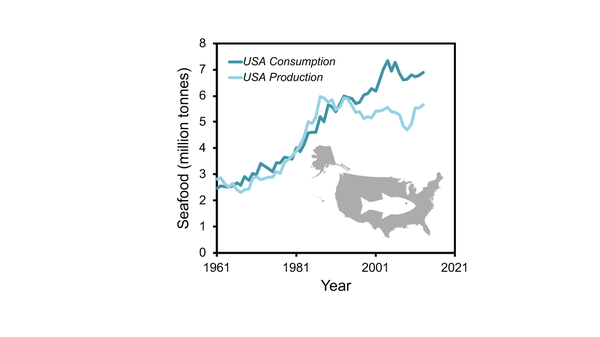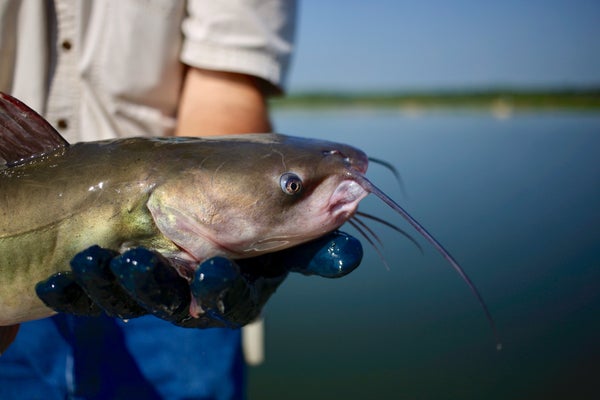This article was published in Scientific American’s former blog network and reflects the views of the author, not necessarily those of Scientific American
Demand for seafood is increasing across the globe, and the United States is no exception. Aquaculture, or aquatic farming, is increasingly meeting this demand and now supplies just over 50 percent of all seafood globally. In fact, it has been one of the world’s fastest growing food sectors for years.
The U.S. is the largest importer of seafood in the world, and some of Americans’ favorites—including shrimp, salmon and tilapia—are predominantly farmed these days. Yet, we contribute less than 1 percent of the world’s total aquaculture production. This means we rely heavily on other countries to satisfy our appetites for seafood.
If the U.S. does not increase its domestic production of farmed shellfish, seaweed and finfish, the divergence between what we consume and what we contribute to the global seafood market will continue to widen. This gap may make it harder for our seafood diets to be sustainable. It also means the U.S. won’t have a hand in shaping the standards or economies that contribute to the seafood sector as a whole in the future.
On supporting science journalism
If you're enjoying this article, consider supporting our award-winning journalism by subscribing. By purchasing a subscription you are helping to ensure the future of impactful stories about the discoveries and ideas shaping our world today.
A brand-new bill that proposes a moratorium on commercial permits for marine finfish aquaculture facilities in U.S. waters could serve to widen this gap, and it represents another divergence: between public wariness about domestic aquaculture operations and the science showing aquaculture’s potential for sustainable growth.
While wild-caught fisheries have hit “peak fish” domestically and globally, with limited potential for additional sustainable growth, there is mounting scientific evidence that the U.S. could dramatically increase domestic aquaculture production and do so sustainably, as we did with our fisheries before they peaked. And this growth does not have to come at the cost of our wild-caught fisheries or other priorities for our oceans, especially under careful management and planning.

Total United States seafood consumption and production (fisheries and aquaculture) over time. Data from FAOSTAT. Credit: Halley E. Froehlich
The oceans, including around the U.S., have a lot of space to put sustainable aquaculture operations, and the amount of space required to farm a lot of seafood is miniscule compared to land-based farming. In fact, farming aquatic species instead of livestock could spare a lot of land because we wouldn’t have to grow as much feed, even as crops replace more limited aquatic feed resources, like sardines and anchovies.
Some aquaculture species, like oysters and seaweed, don’t even require farmers to feed them, and they can actually improve environmental conditions by filtering nutrients and mitigating some climate change impacts.
Like all food production systems, aquaculture will have an impact, with challenges around minimizing disease, contaminants, pollution, escapes, and disturbing wild species. The alternative to open ocean farms—closed, land-based farms—are part of the solution, but have their own trade-offs, like limited places to put them, greater water demands and greater green-house gas emissions.
Importantly, not all aquaculture is created equal. The U.S. has the opportunity to employ clear and strong regulatory standards that also consider our wild fisheries and marine ecosystems.
The perceptions of some policymakers and the public could determine the rejection or adoption of aquaculture in the country. Social research shows Americans are willing to eat farmed seafood but are concerned about the development of aquatic farms in their “backyards.” Fears about escapes, like one in Washington State that resulted in a statewide ban on Atlantic salmon, and worries based on a history of poor farming practices and pathogens, are not baseless. People are fallible, but good management and monitoring can reduce negative impacts.
Legislators at federal and state levels are considering and constructing policies that could facilitate some types of domestic aquaculture production. In Alaska and California, for example, marine shellfish and seaweed aquaculture are taking center stage. There are continued attempts to create a clear federal law governing marine aquaculture nationally, but there is still a long way to go.
If the U.S. wants a future with more local and sustainable seafood production, part of the solution is better communication of what sustainable aquaculture looks like and who are the people working in that space, including chefs, scientists, conservationists and farmers. This can help raise awareness of the realities of seafood production and demand, and of the potential for sustainable aquaculture. Already, there is evidence that improved communication works.
At the policy level, we need more evidence-informed conversations and policies around the future of domestic aquaculture that address important philosophical questions—namely, where do we want our food to come from and what, if any, role should we play in its production? Can aquaculture have its own Magnuson-Stevens Act, which changed the game for the sustainability of our wild fisheries?
The reality is Americans, and the growing global population, won’t stop eating seafood any time soon, and our reliance on it may continue to grow if we are going to feed the world sustainably. Aquaculture is part of our diets now and will be into the future.
The narrative needs to move away from “wild versus farmed” and toward “wild and farmed.” Let’s have serious, informed conversations about the state of seafood and how the U.S. can both contribute to and benefit from sustainable Blue Growth.
